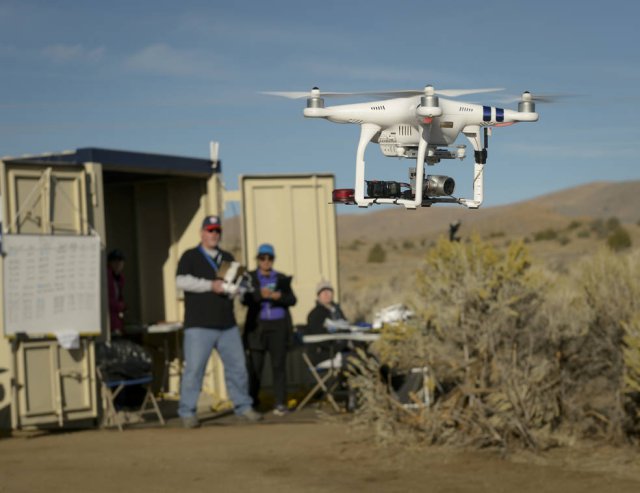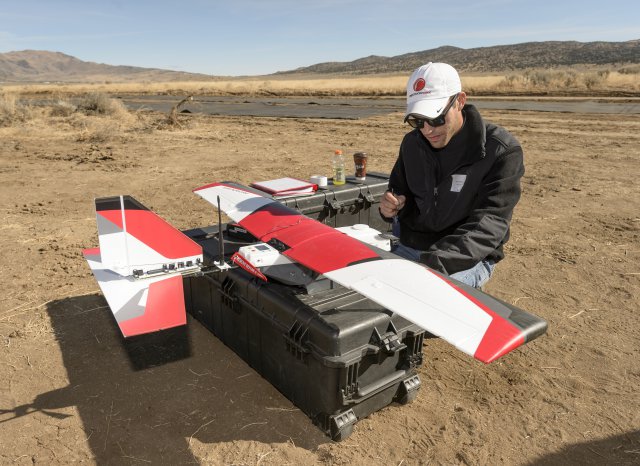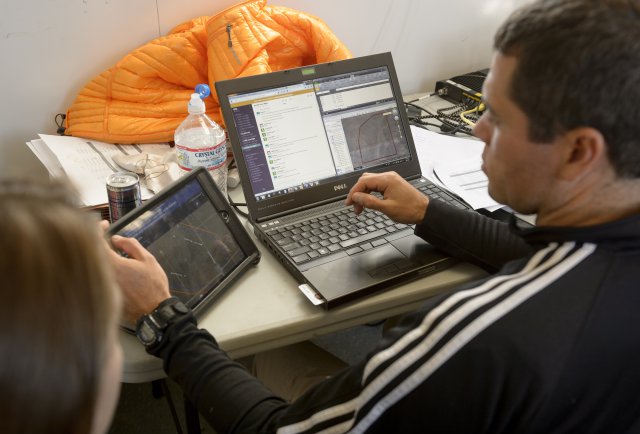 In mid-October NASA partners will fly five unmanned aircraft systems (UAS), commonly called drones, beyond visual line-of-sight of their human operators-in-command, to test planning, tracking and alerting capabilities of NASA’s UAS traffic management (UTM) research platform.
In mid-October NASA partners will fly five unmanned aircraft systems (UAS), commonly called drones, beyond visual line-of-sight of their human operators-in-command, to test planning, tracking and alerting capabilities of NASA’s UAS traffic management (UTM) research platform.
During the test, two of the drones will fly beyond visual line-of-sight, and up to three drones will fly in the same test airspace, separated by altitude and within line-of-sight of their operators. The pilots will use the UTM research platform to give them information about all drones’ locations and proximity to surrounding operations. UTM will inform airspace users of potential hazards and conflicting operations that may impact their plans.
Before multiple drones can fly in the same area, beyond the pilots’ view, procedures need to be in place to safely manage the traffic. Operators must be aware of other operations around them, as well as any no-fly zones known as geo-fenced areas, and be alerted of hazards such as severe weather affected airspace, or unplanned events that change their plans. Addressing these challenges is the next step to safely integrating drones into the national airspace.

Precision Hawk pilot readies aircraft for test flight.
Credits: NASA Ames / Dominic Hart
During the test NASA will demonstrate UTM’s Technical Capability Level 2 (TCL2) by connecting real drone tracking systems to the research platform, providing alerts for approaching drones and manned aircraft (live or simulated), as well as providing information about weather or other hazards. UTM partners will use various unmanned aircraft connected to the research platform to test beyond line-of-sight UAS operations so that NASA, in collaboration with the Federal Aviation Administration (FAA), can obtain information to further refine and develop the research. Because this is a test, all necessary safety precautions are taken and every vehicle will be continuously monitored visually by observers, ensuring safe operation even when drones are beyond the line of sight of the operator-in-command.
When the three drones fly close to each other, they will be within view of their operators. Currently, FAA regulations require that drone operators be able to see other aircraft in order to avoid them, which limits many potential applications for UAS technology. The UTM demonstration will gather information that will help regulators and researchers assess the capabilities and procedures that could support beyond visual line-of-sight operations. The operators will also use common data exchange protocols—developed jointly by NASA, industry, and FAA—to make notifications of their intended use of airspace as well as any real-time constraints.
This test boasts several firsts:
- First UTM demonstration of multiple drones flying and landing beyond visual line-of-sight of the pilot, with paths separated by altitude. This uses the UTM research platform for information about potential hazards and conflicting operations.
- First demonstration of prioritizing airspace access for emergency response drones through UTM airspace management combined with notification to other UAS operators to clear the area to allow emergency responders access.
- First demonstration of system detect-and-alert capabilities. Live radar and weather systems will provide alerts to UTM operators based on real data measurements. The team will further test the capability by introducing simulated weather events, such as high winds, to obtain operator feedback and further refine the capability.
- First demonstration of automated alert when aircraft are not conforming to their flight plans. This safety feature warns UAS operators and in future FAA systems of these hazards, such as another drone flying away from its planned path or loss of connection with an operator.
- First demonstration of dynamic re-routing capability that allows an unmanned airborne vehicle to request flight plan changes. This function allows operators to update their missions in response to either changing airspace conditions or new mission objectives.
Engineers at NASA’s Ames Research Center, located in California’s Silicon Valley, have conducted several flight tests to develop and evaluate requirements needed to make low-altitude UAS operations safe and efficient. In April 2016, NASA and operators from several FAA UAS test sites across the country flew 22 drones simultaneously, the first and largest demonstration of its kind, to assess rural operations of NASA’s UTM research platform. In November 2015 NASA’s UTM team field-tested rural UAS operations with drones operating in separated flight areas that pilots reserved using the UTM research platform.

Engineer reviews flight paths using the UAS traffic management research platform
Credits: NASA Ames / Dominic Hart
Upon completion of UTM TCL2 tests, NASA will offer these capabilities to all FAA test sites for further validation and assessment of UTM TCL2. UTM’s Technical Capability Level Three testing is planned for January 2018 and will involve evaluating tracking procedures for managing cooperative and uncooperative drones to ensure collective safety of manned and unmanned operations over moderately populated areas. Technical Capability Level Four planned for 2019 will involve higher-density urban areas for autonomous vehicles used for newsgathering and package delivery, and will offer large-scale contingency mitigation.
Source: Press Release
